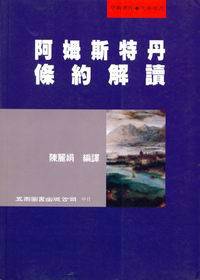-
阿姆斯特丹条约 编辑
欧盟理事会总秘书处在1997年6月中旬公布了欧洲理事会的阿姆斯特丹会议文件,其中包括由欧盟首脑会议通过的《阿姆斯特丹条约》(以下简称《阿约》)草案。该《阿约》草案有6个部分共19章。从条文内容来看,《阿约》是对欧盟已有条约(主要是《马斯特里赫特条约》与《罗马条约》)的一项修正案,主要是通过改写、添加或删节现有条约条款及附件如议定书、声明、宣言等,对之进行修订和增补。《阿约》的第一部分两章成文主要是加强联盟公民权利及其保护的规定。
中文名:阿姆斯特丹条约
人物:欧盟理事会总秘书处
地点:荷兰的马斯垂克
公布时间 :1997年6月
1996年3月29日欧洲联盟高峰会议在意大利杜林(Turin)召开,就欧洲联盟整合的各项议题展开协商,并于1997年10月2日于荷兰阿姆斯特丹举行的欧盟高峰会议中,由各国外交部长就协商结果签订了阿姆斯特丹条约,以下便简介该条约的重要内容及后续发展。
欧盟委员会主席桑特在讲话中说,阿约的达成表明了欧盟在深化一体化方面取得了进步。《阿约》为建设“社会的欧洲”建立了法律基础。在共同外交安全政策方面,欧盟各国也表现出了一定的政治意愿。但他同时指出,表决机制的改革并没有达到预期的目标。桑特承认,欧洲一体化已经到了每前进一步都是非常困难的阶段。
此次签署的条约附件中增加了法国、意大利和比利时三国9月中发表的共同声明。声明明确指出,《阿约》在改革欧盟机构以加强欧盟决策权方面没有取得实质性进展。
《阿姆斯特丹条约》是1997年6月中旬达成的,它是继《罗马条约》和《马斯特里赫特条约》后的第三个欧盟条约。欧盟成员国为准备这项为扩大欧盟奠定基础的条约,以政府间会议的形式进行了长达15个月的艰苦谈判。
第二章提出了“逐步建立一个自由、安全和公正的区域”的新目标,并在《罗马条约》中增补了一编“人员自由流动、避难与移民”,将《马约》的第三支柱“民政与司法合作”(第六编)中与人员自由流动相关的民政与司法事务移植升格为共同体行动(但英国、爱尔兰与丹麦保留了自愿参与的权利)。另一个发展是通过增添“一项议定书,将已有13个成员国(除英国与爱尔兰)签署加入的《申根协定》事务纳入了欧盟。
《阿约》第二部分成文共9章,是使欧盟“更加贴近”其公民的一些内容。第三章将“高度就业”作为目标增写进《马约》与《罗马条约》。
第四章改写了《罗马条约》有关社会政策的条款。
第五章将“可持续发展”的概念作为原则与目标写入了有关条约,并将原在《罗马条约》“环境保护”一编的一项规定——在界定和实施共同体政策与活动时,必须包括环境保护的要求一作为新条款移至该条的“原则”部分(第3D条),即将此规定升格为欧共体的一项原则。
第六章改写了《罗马条约》关于公共卫生的第129条,要求在界定和实施欧共同体政策与活动时,应保障高度的公众健康。
第七章改写了《罗马条约》关于消费者保护的第129A条,新增添的内容包括:第一,要求欧共同体为保护消费者的健康。安全与经济利益作出贡献;第二,在界定和实施共同体政策与活动时,应考虑到消费者保护的要求。
第八章涉及联盟公民、文化,体育、边远地区与海外领地等众多方面,其中改写了《罗马条约》有关反对欺诈舞弊的第209A条,赋予共同体对损害其财政利益的欺诈行为采取必要措施的权利。
第九章为增加《罗马条约》的一项议定书,对该条约第3A条的“辅从原则”作了进一步界定。
第十章对欧盟立法的透明度作出了一些规定:一是将《马约》第A条中 “决策的作出应尽可能地贴近其公民”的条文,改写为:“决策的作出应尽可能地公开和尽可能地贴近其公民”。二是在《罗马条约》中增添了第191A条,规定任何联盟公民、自然人与法人都有权根据有关规定取得欧盟机构的文件。
第十一章是写入《条约》附录的一项声明。要求欧盟有关机构提高立法文件的质量,使之能被公众更好地理解和得到有关方面更好的贯彻。《阿约》第三部分成文两章是有关欧盟对外政策的条款
第十二章改写了《马约》关于共同外交与安全政策的条款由原来的11条增加为18条。
第十三章是对《罗马条约》的增补,是赋予欧盟在共同贸易政策结构内谈判和缔结有关服务业及知识产权国际协定的权利。《阿约》第四部分成文6 章是关于欧盟机构改革的规定。
第十四章增添了三项内容:第一,欧盟决策必须得到议会的同意,其中包括对违背基本权利的成员国实行制裁,接受新成员国,缔结某些国际协走等;第二,新增了23类立法,简化了实施程序;第三,规定今后欧洲议会成员的总数不得超过700名。
第十五章增加了16类立法。
第十六章增添了三项内容:第一,欧洲议会在任命委员会主席时的作用,规定成员国政府以共同协议作出的委员会主席提名,必须得到欧洲议会的同意;第二,规定委员会其他成员将由成员国政府与已提名的委员会主席以共同协议提名;第三,规定委员会应在主席的“政治领导”下开展工作。
第十六和十八章分别对法院与审计院、经社委员会,地区委员会的职责和权利作了调整。
第十九章对成员国议会在欧盟决策中的作用作了一些规定:
第一,委员会白皮书、绿皮书、通讯与立法提案均应提供给各国议会,在理事会讨论立法提案前应留出6 周时间让各国议会提出意见;
第二,赋予1989年建立的各国议会欧洲事务小组委员会会议就欧盟立法提案提出意见的权利。《阿约》第五部分没有分章。在《马约》与《罗马条约》中增添了新条款,规定在特定前提下,部分成员国可以利用欧盟或欧共体的机构。程序与机制在它们之间建立更为紧密的合作。《阿约》第六部分,是关于简化和合关欧盟各条约的问题。
The Amsterdam Treaty meant a greater emphasis on citizenship and the rights of individuals, more democracy in the shape of increased powers for the European Parliament, a new title on employment, a Community area of freedom, security and justice, the beginnings of a common foreign and security policy (CFSP) and the reform of the institutions in the run-up to enlargement.
Contents
Amsterdam comprises 13 Protocols, 51 Declarations adopted by the Conference and 8 Declarations by Member STATes plus amendments to the existing Treaties set out in 15 Articles. Article 1 (containing 16 paragraphs) amends the general provisions of the Treaty on European Union and covers the CFSP and cooperation in criminal and police matters. The next four Articles (70 paragraphs) amend the EC Treaty, the European Coal and Steel Community Treaty (which expired in 2002), the Euratom Treaty and the Act conceRNIng the elECTion of the European Parliament. The final provisions contain four Articles. The new Treaty also set out to simplify the Community Treaties, deleting more than 56 obsolete articles and renumbering the rest in order to make the whole more legible. By way of example, Article 189b on the codecision procedure became Article 251.
Main amendments
Four key chapters were affected: citizenship and fundamental rights, the establishment of an area of freedom, security and justice, the CFSP and the reform of the institutions.
The Treaty opened the way for dialogue between the EU and its citizens by safeguarding fundamental rights (for the first time Member States failing to reSPECT such rights may face penalties), tackling discrimination of all kinds, providing for equal opportunities for men and women, focusing on social issues and assets such as voluntary work, sport, public-service television broadcasting, disability, churches and non-confessional organisations, public credit institutions operating in certain countries and a rejection of the death penalty. But the Treaty also dealt with the major issues facing our society such as employment, the environment, public health and open government.
The most pressing concerns of ordinary Europeans, such as their legal and personal security, immigration and fraud prevention, were all dealt with in other chapters of the Treaty. In particular, the EU will now be able to legislate on immigration, civil law or civil procedure, insofar as this is necessary for the free movement of persons within the EU. At the same time, intergovernmental cooperation was intensified in the police and criminal justice field so that Member States will be able to coordinate their activities more effectively. The Union aims to establish an area of freedom, security and justice for its citizens. The Schengen Agreements have now been incorporated into the legal system of the EU. (Ireland and the UK remained outside the Schengen agreement, see Common Travel Area for details)
The Treaty lays down new principles and responsibilities in the field of the common foreign and security policy, with the emphasis on projecting the EU's values to the outside world, protecting its interests and reforming its modes of action. The European Council will lay down common strategies, which will then be put into effect by the Council acting by a qualified majority, subject to certain conditions. In other cases, some States may choose to abstain "constructively", i.e. without actually preventing decisions being taken.
The treaty introduced a High Representative for EU Foreign Policy who, together with the Presidents of the Council and the European Commission, puts a "name and a face" on EU policy in the outside world. Although the Amsterdam Treaty did not provide for a common defence, it did increase the EU's responsibilities for peacekeeping and humanitarian work, in particular by forging closer links with Western European Union.
As for the institutions, there were two major reforms concerning the codecision procedure (the legislative procedure involving the European Parliament and the Council), affecting its scope - most legislation was adopted by the codecision procedure - and its detailed procedures, with Parliament playing a much stronger role. The President of the Commission will also have to earn the personal trust of Parliament, which will give him the authority to lay down the Commission's policy guidelines and play an active part in choosing the Members of the Commission by deciding on their appointment by common accord with the national governments. These provisions make the Commission more politically accountable, particularly vis-à-vis the European Parliament. Finally, the new Treaty opens the door, under very strict conditions, to closer cooperation between Member States which so wish. Closer cooperation may be established, on a proposal from the Commission, in cases where it is not possible to take joint action, provided that such steps do not undermine the coherence of the EU or the rights and equality of its citizens.










